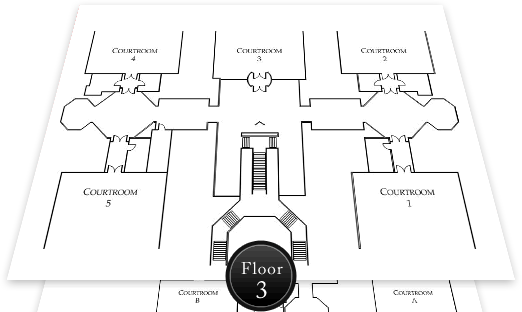Welcome
The United States District Court for the District of New Hampshire invites you to view the historical exhibits displayed throughout the public areas of the first and third floors of the Warren B. Rudman Courthouse, located at 55 Pleasant Street in Concord. Members of the public may tour the hallway exhibits during regular hours of court business (weekdays, 8:30am – 5pm.) Conference room exhibits may also be viewed whenever the rooms are not in use by attorneys, litigants, or court staff.
Walking Tour of Exhibits
The statue that stands just inside the courthouse entrance is a blindfolded female figure, named for its representation of the timeless concept of Justice. This contemporary sculpture, crafted by artist and sculptor Diana Moore, is designated Exhibit #1. An easy walking tour of our historical exhibits starts inside the Clerk’s Office with Exhibit #8, which gives a synopsis of the role the Clerk of Court and staff play in the administration of justice. Exhibit #2, on the wall just outside the Clerk’s Office, begins our study of New Hampshire history with a piece on Native American tribes known as the Abenaki, whose presence in our state dates back at least 10,000 years.
While the rest of our first floor exhibits focus primarily on New Hampshire history, some incorporate both state and national, or international, components. For instance, Exhibit #15 tells of international policy achievements reached in 1905 and 1945 in the accommodations of two of New Hampshire’s grand hotels. Exhibit #27, on the Constitutional Convention of 1787, includes information on New Hampshire’s two delegates. Exhibit #18’s explanation of the federal court magistrate system features photos of retired magistrate judges from this district.
As you proceed upstairs, you’ll find the “silver oar” display at the mezzanine. This exhibit (#30) honors the historical link between our current district courts, colonial America’s vice-admiralty courts, and the admiralty courts of England (dating from circa 1360.) A memorial plaque honoring Senator Warren Rudman is displayed just to the left of the entrance to Courtroom 3. Portraits of all past Article III judges from our district are displayed at both ends of the third floor. The main hallway near Courtrooms 1 and 2 features two important events that surround the nation’s founding in 1776: the Declaration of Independence and the Revolutionary War’s battle of Trenton. The main hallway exhibits near Courtrooms 4 and 5 reflect on Abraham Lincoln’s presidency and the America’s civil rights struggles of the twentieth century.
For a printable copy of our Walking Tour Guide, click here.
Virtual Tour of Exhibits
A compilation of the essays and prints comprising our historical exhibits can be perused via the following interactive, guided web tour. We hope you enjoy the experience!


Choose a Floor...Choose an Exhibit
Click one of the maps above to visit the exhibits on either the first or third floor. Then select the exhibit you would like top view from either the listing of exhibits on the left side or from the map.
Note: The artwork displayed in our exhibits is protected to the full extent of copyright law. Digital images of artwork appear on this website solely for the purposes of scholarship and research. The District Court does not convey any license or permission to copy, distribute, publicly display or otherwise publish any content or image, or to make derivative works from such content or image. The commercial reproduction of content and images from the exhibits is strictly prohibited except with the express written permission of the appropriate rights holders; moreover, the reduced resolution of the website images renders them unsuitable for reproduction.
